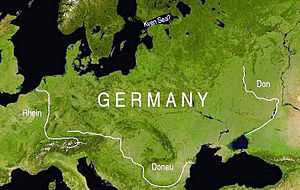Kven Sea
Kven Sea (Cwen sea) is mentioned as the northern border for the ancient Germany in the "The Old English Orosius", the history of the world published in England in 890 CE with a commission from King Alfred the Great himself. It was probably the same as the Gulf of Finland, although Arctic Ocean and Gulf of Bothnia have also been suggested.
Kven Sea in Orosius
Included in Orosius, there is a short description of Kvenland by a Norwegian viking Ottar. It seems probable that information about Kven Sea was originally also from him. Kven Sea by that name is unknown outside Orosius.
Borders of the ancient Germany were described in Orosius as follows:[1]

- "From the Tanais (River Don) westwards to the Rhine, which takes its rise in the Alps, and runs northward, till it falls into that branch of the ocean which surrounds Bryttannia, and southward from the Tanais to the Donua or Danube, whose source is near that of the Rhine, and which runs to the northward of Greece, till it empties itself into the Euxine, and north even to that part of the ocean which is called the Kven Sea (Cwen sea), there are many nations; and the whole of this extensive country is called Germany."
It seems that the text refers to the Arctic Ocean (or its southern part Barents Sea, or even the White Sea), but gives it a name "Kven Sea".[2] The name is however not found anywhere else. The text does not cite Ottar as its source, but it seems reasonable to assume so. Ottar's story elsewhere in Orosius[3] contained a lengthy description how he sailed along the coast of Arctic Ocean far to the east, presumably even deep into the White Sea. He listed different people he met along the way, but he did not mention Kvens to have any presence on that area. Thus it would not be expected that he had named that sea as the "Kven Sea" if there were no Kvens around at all.
Scribes working on Orosius had other problems with the northern seas:
- "The Swedes (Sweons) have to the south the arm of the sea called Ost --"
which refers to the Baltic Sea, including Kattegat and Skagerrak. However, Baltic Sea extends to the east of Sweden as well and further deep to the north. As it seems that the scribes had lost most of the Baltic Sea from their notes, that gives room to the idea that it had been combined together with the Arctic Ocean. This approach would move the "Kven Sea" on the Baltic Sea. Gulf of Bothnia, the northernmost section of the Baltic Sea, has been speculated to be the same as the Kven Sea.[4] An equal possibility is Gulf of Finland. This might even be more likely, since Vikings' eastern routes along the Russian rivers to the Black Sea, Constantinople and Greece started from the Gulf of Finland and having Gulf of Finland as the northern border for the ancient Germany is more suitable than Gulf of Bothnia.
Kven Sea in other sources
Noteworthy is the total absence of the name "Kven Sea" from all Norwegian and Swedish sources. Sagas that describe the era during which Ottar lived, use the name "Helsingjabotn" for the Gulf of Bothnia, for example in the Orkneyinga saga.[5] If Kven Sea was a name used for the Gulf of Bothnia, it along with all of its possible variations seem to be completely missing from the Scandinavian namespace in later times. This is easiest explained so that they were not the same. It has however been suggested that "Kajano More"[6] appearing in Russian documents from the 14th to 16th centuries in different spellings as the name for the Gulf of Bothnia might have been an equivalent of Kven Sea.[7] This however does not explain its absence in Scandinavian sources.
If the name "Kven Sea" was used for the Gulf of Finland and if, as it seems probable, "Kven" was originally a dialectal Norwegian name for "Finn", there is a clear continuum of the name as Finska viken in both Swedish and Norwegian. It must also be noted that Gulf of Finland was called a sea of its own still in the 16th century.[8] In the north, Kven Sea and Finska viken are also the only seas, or parts of bigger seas, that are known to contain a name of a nationality.
References
- ↑ Geography of Alfred
- ↑ Styffe, Carl Gustav. Skandinavien under unionstiden. (Stockholm 1876). Pp. 300-314.
- ↑ Ottar's description of northern people
- ↑ Julku, Kyösti. Kvenland - Kainuunmaa (1986). See page 95. Book is in Finnish. Julku claims that Kven Sea was the same as Gulf of Bothnia, but he does not reason the speculation in any way.
- ↑ Orkneyinga saga. Original text here.
- ↑ Nöteborgsfreden och Finlands medeltida östgräns. Andra delen. Skrifter utgivna av Svenska litteratursällskapet i Finland, Nr 427:2, VIII + s. 239-509. Helsingfors 1991. (97:1, 186-200). More about Russian border documentation between the 14th and 16th centuries.
- ↑ Julku, Kyösti. Kvenland - Kainuunmaa (1986). See page 95.
- ↑ Mare Finonicum in the Olaus Magnus map of Scandinavia from 1539 CE.